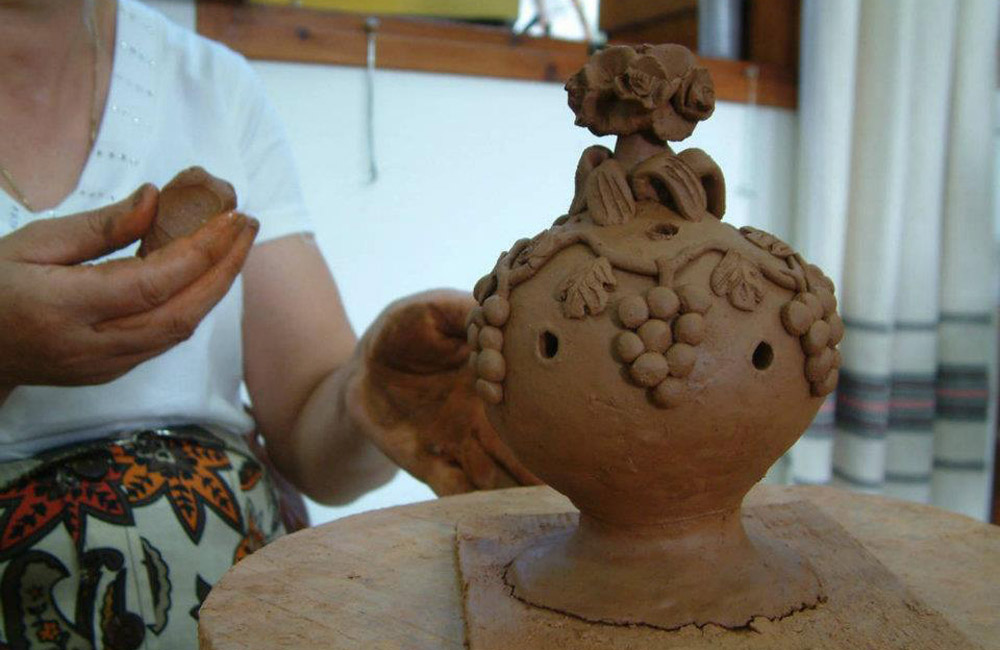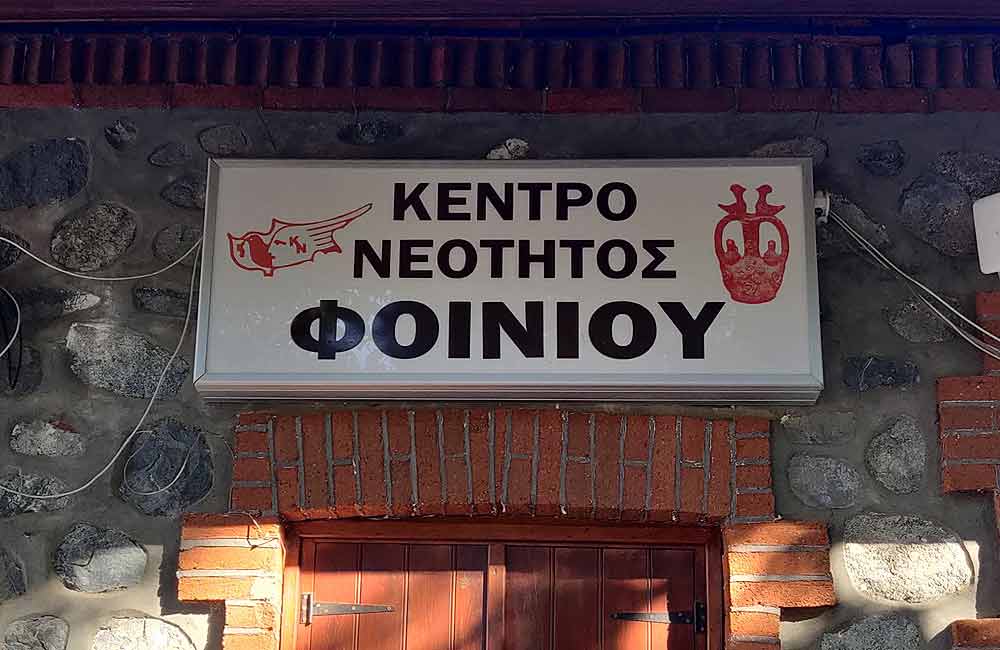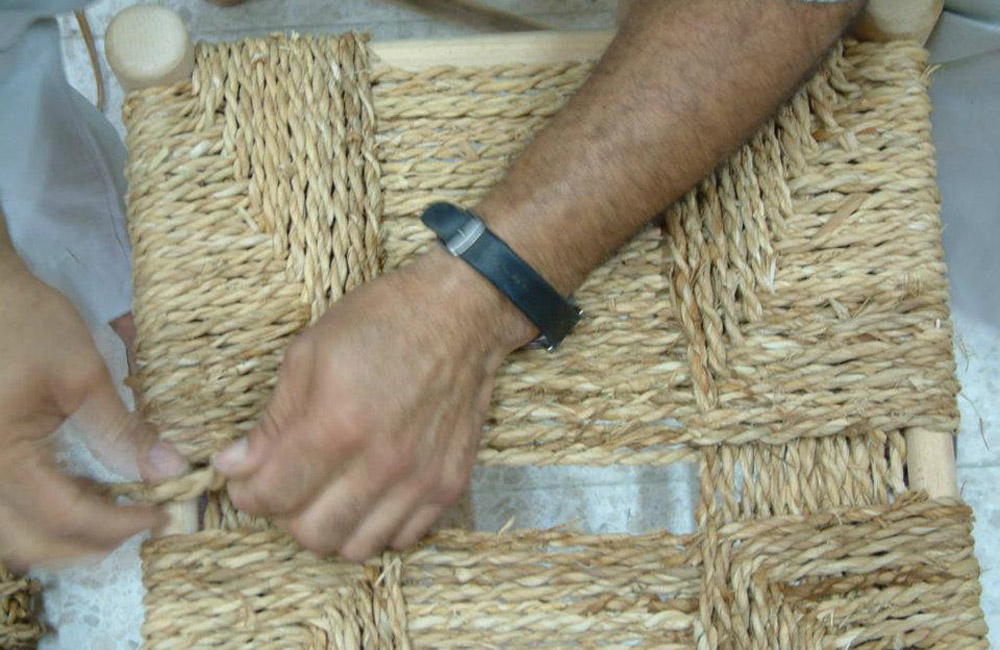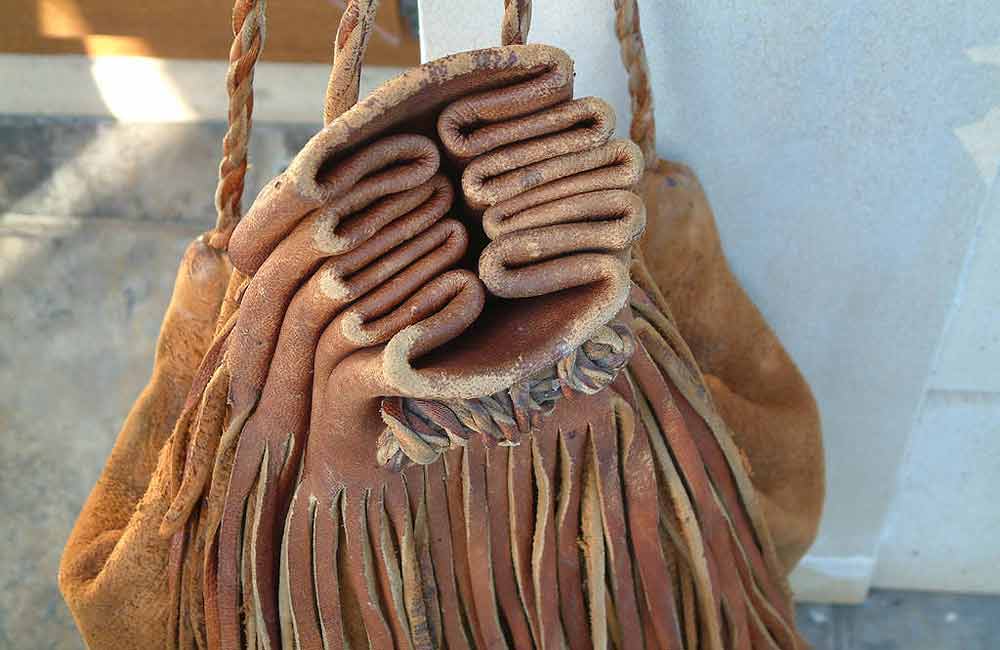The craft of pottery was introduced to the life of the Cypriots since the Neolithic era. The Cypriot craftsman quickly used the plastic traits of clay from the substratum of Cyprus and manufactured vessels so as to serve his daily needs. The emergence of this craft brought revolutionary changes in his everyday life. Inspired by the environment, the nature of Cyprus, and according with his/her psychological mood, intelligence and craftsmanship, the craftsman selected that which was useful to him/her. The influences were many and continual. However, in spite of the many influences by each of the conquerors and the neighbouring people, he/she had the ability to select that which was useful to him/her and to express it with an idiosyncratic local character thus adding it to the archive of the civilisation of Cyprus. Each era had its own centres of production with distinct local characteristics.
The village of Phini developed a unique and extensive tradition in pottery, the history of which goes back into the centuries. During the past centuries it has been one of the four most important centres of the craft of pottery in Cyprus. The pots manufactured until today in this village are red, porous, and similar to those of Kornos.
Phini is located south of the mountain range of Troodos, 3 kilometres from the holy monastery of Trooditissa and 6 kilometres from the mountain resort of Platres, constituting the western end of the wine-making villages. The ground morphology, as well as the stony mountains, combined with the direct dependency of their incomes to the weather conditions, have forced the inhabitants to turn to a second profession -that of the potter -so as to improve their financial resources and increase the family income.
This craft had been a profitable occupation for a large number of inhabitants. Entire families lived off this profession. The men were mainly jar makers. The women mostly manufactured objects for the keeping and carrying of agricultural products and of water. Nowadays, this craft has prevailed as a profession for females. The wellbeing and growth of the village -due to the incomes of this craft -have been the reason for its later expansion in the villages Kaminaria and Agios Demetrios. In the last century, the craft of pottery has evolved and has been preserved as home handicraft.\

The preparation of raw material
Finding, collecting, and carrying the raw material is mostly a man's job. Two types of soil are usually needed for the preparation of the clay -the white one and the red one -derived from areas surrounding the village. After excavating follows the spreading and drying of the soil. Then the "pounding" takes place so as to break down the clots. This is achieved with a wooden stick (called "Coupani") made out of hard wood. The sifting -done with a special sandbox -occurs afterward so as to remove the stones and other extraneous objects. Working the clay takes place in a specially made basin. Once the proper content of soil admixture is prepared, it is sprinkled with water and then stirred with a special wooden shovel. Then follows the transfer of the clay to the work area.
The making of the pots
Phini's handmade pots are still made in the same way they were made thousands of years ago without any great changes. Forming the pots takes place on the traditional "gyristari" (lathe). A 5th century BC model is exhibited in the British Museum. The sitting craftswoman places the lathe low and in front of her with the clay piled on the side. A pine cork is fastened on the surface of the lathe with three little pieces of clay, making the craftswoman's work easier as it is also used to transport the pot -right after it is made -while it is still soft.
A piece of clay in the shape of a ball and of about 2 to 3 kilos, depending on the size of the pot to be made, is placed in the centre of the cork's surface. The lathe is rotated and the craftswoman uses her fist to softly pound on the ball thus creating the base of the pot. Then, pushing internally with the left hand and externally with the right one, she fashions the walls of the pot giving them the appropriate shape. Whenever needed, the potter's wheel is rotated and guided by foot. This is repeated many times until the figure of the pot is completed. At times the craftswoman wets the pot with a little, wet piece of cloth so as to aid the clay move upwardly with more ease.
After shaping the pot, the craftswoman will polish its walls with a wet cloth and with the aid of a straw she will create the various designs upon the pot.
Then she will set it side somewhere in the shade, away from the air currents, until the next day.
The day after, she will remove the clay from the base of the pot with a wooden knife so at to make it evenly thick.
Then she will polish it with a wet cloth and slightly glaze it with the outer side of the straw.
Depending on the type of the pot, she will add to it handles and plastic decoration such as daisies, pinecones, small birds, little people, etc.
Drying in a shady place follows. When completely dried up, the pots are ready for the kiln.
The jars
The imported, specialised, industrial products and the appearance of mass production items in the market have replaced handmade articles. Jars had the same fate. Their manufacture was difficult and time consuming and so their production was halted in the beginning of the 70's.
These pots were large and so they were mainly manufactured at their place of use. They were made mostly by men, the "pitharades" (pithari = jar). The raw material that they used came from the surrounding areas of the village. When the jars were to be made in other villages, the buyer of the jar carried the soil for its manufacture from Phini to his/her village. Transferring the soil was done by the buyer's men, which were name "chomatarides" (choma = soil). During the months of Spring and Summer the jar-maker went to the buyer's village in order to manufacture the jars. The preparation of raw material is the same as for the other pots.
Manufacturing the jar would last 20-45 days, depending on their size. The jar-maker would take a piece of clay weighing 3-4 kilos so as to create the first part of the jar, its base. This had to be thick enough so as to sustain the rest of the jar's weight. On the same day, he would manufacture the forepart for 20-25 jars. Every day he would place and join a ring to each of them, that is, he prepared a roll made of clay and joined it over the previous one creating the shape of the jar. It was necessary that the new ring was kept moist until the next day so the jar-maker covered the pots with leafs from a wine or a walnut tree. Then the jar-maker would model a new, thick roll of clay and spread it evenly over the lips of the previous ring of the previous day. This process lasted 4-6 weeks, depending on the size of the jar. Drying followed, which lasted about 10-15 days. Baking occurred in large, special kiln that would hold 3-9 jars, depending on their size.
Many of the jars carry the name of the maker and the date of production inscribed on them. Some jars also carry the name of the buyer.
"Baking" of the pots
After drying up, the pots are baked in a wood-burning kiln. First, the large pots go in and then follow the smaller ones. The fire burns in the lower chamber and the temperature is transferred -through the holes on the floor -to the upper level. Baking lasts up to 10 to 12 hours, depending on the size of the pots. Initially, the kiln is pre-heated and gradually the heat grows stronger. Baking the pots is done experientially by expert potters. When the cycle of baking is completed and the temperature of the kiln is reduced, namely after 10 to 12 hours, the pots are ready to use.
"Baking" of the jars
After drying up, the jars also had to be baked in a wood-burning kiln. Transferring the jar to the kiln was done through the use of a matt and a bag, upon which the jars were carefully rolled. The jars are placed in the kiln with care, first the large and then the smaller ones. Baking the jars was done in the same way as the baking of the pots. Jars needed 3 days to be baked. After being baked the jars had to be pitched with tar and vinegar. When the jars were hot their pores were open; with tar and vinegar the pores were filled and so the jar acquired an internal waterproofing property.
There is no doubt that for both the male and female potter of Phini, the art of pottery was a harsh and laborious process. But at the same time it was creative work that allowed the maker to rejoice for the works of his/her hands.
Today the functionality and usage of these pots has been downgraded since the markets have been overwhelmed by mass production articles that supersede handmade products. The emergence of various forms of industrial products in the decade of 1960 was the beginning of the abandonment of this art. At the same time, the modern way of living has altered the usage of pots and, as a result, the few women that are occupied with their manufacture today are mostly limited to decorative pots.
The Cyprus Handicraft Services (Ministry of Commerce, Industry and Tourism) in collaboration with the community, the Association of Emigrants of Phini, and other organisations have undertaken a multifaceted effort for researching, rescuing, and promoting the art of pottery and -simultaneously -encouraging the young to study the trade of the potter. In the area of the old primary school, a special pottery department has been created and in it anyone can learn about this traditional craft. It is the duty of all of us to contribute to the preservation of our folkloric elements, which define us as people and as a nation, because they are a valuable historical record for the knowledge of the culture of Cyprus.

The coin of 10 cents of the Cyprus Pound
Phini is unquestionably one of the most important centres of pottery art in Cyprus. Up to the beginning of the 19th century, almost every house in the village was also a small pottery workshop. Women were crafting small household and other pots needed for their day to day activities such us small jars (kouzes), candlesticks, vases etc. whilst men were taking over the hardest part of the work which included the design and structuring of the jars. Both pots and jars were made of red potter’s clay called the “phinikoun” which was found in the area.
The decision of the Republic of Cyprus in 1983 to choose a modern clay vase of Phini depicting flowers and birds to be illustrated on the reverse of the 10 cents coin proofs the uniqueness of the pottery art of the village.




